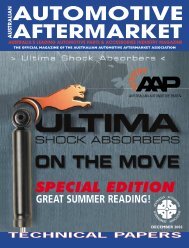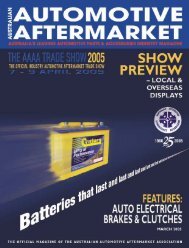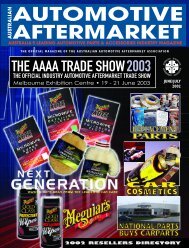AM MAGAZINE SHELL - Australian Automotive Aftermarket Magazine
AM MAGAZINE SHELL - Australian Automotive Aftermarket Magazine
AM MAGAZINE SHELL - Australian Automotive Aftermarket Magazine
- No tags were found...
Create successful ePaper yourself
Turn your PDF publications into a flip-book with our unique Google optimized e-Paper software.
TECHNICAL COLUMNBut there is little doubt that the injurywould have been much worse had Massa notbeen wearing one of the latest FIA 8860-2004 standard helmets compulsory for all F1and many other (including V8 Supercars)motorsports.The development objectives for this newhelmet was to make it 50 percent stronger,whilst reducing weight, and limiting thestrains on a driver’s head and neck whensubjected to high G impacts.The basic design consists of a hardouter shell and an energy-absorbing innerlining.The outer shell is made up of layers ofT1000 aerospace-grade carbon fibrematerial.Beneath these are sheets of aromaticpolyamide, which are strong and heatresistant which were first developed formilitary body armour.The different fibres are bonded togetherusing resin being baked at high pressure andtemperature.The inner liner function is to bring thehead to a stop as gently as possible and thisis achieved by using a combination ofdifferent density lining materials.The outer shell works if it flexes a littlewhen hit, rather than crushing ordelaminating.This helps to reduce the G-forces insidethe helmet.The use of lightweight materials meansthat these helmets can weigh as little as1300 grams but can withstand astonishingforces.The Bell HP3 was the first helmet to meetthe FIA 8860 - 2004 standard.HANS DeviceThe HANS device is a head and necksupport, which is compulsory in most carracing sports.Primarily made of carbon fibre, the deviceis something of a U shape with the ‘U’ fittingbehind the back of the neck and two armslaying flat along the top of the chest andsupported by the shoulders.It is attached to the helmet by twoanchors on either side and not to the safetybelts, driver’s body or seat.The purpose of the device is to stop thehead from ‘whipping forward’ in a crash,without otherwise restricting movement ofthe neck.In a crash the safety harness deceleratesan unprotected body with the headmaintaining velocity until the neckdecelerates it.The HANS device maintains the relativeposition of the head to the body, with thedevice transferring energy to the muchstronger chest, torso and shoulders.Racing SuitsThe latest technology racing suitscomprise of three layers of fabric to maximisefire resistance, breathability and drivercomfort.The outer layer is manufactured from a DuPont registered product called Nomex –developed for US military battlefield clothing-- in combination with carbon fibres tomaximise fire resistance in an ultralightweightfabric.The superior insulation properties ofNomex are also used as a felt in the middleFIG 2: HANS Device worn by NASCAR Veteran Ken Schrader.layer to provide a highly effective heattransfer barrier.The inner layer is designed to provide thedriver with comfort with flat seams to improvecomfort at pressure joints.For endurance type races such asBathurst, there are a number of coolingsystems available for drivers to reduce thepossibility of heat stress and fatigue.Veins are sown into the suit so that coldwater from a refrigeration unit can circulateremoving excess core body temperature,cooling and relaxing the driver in hotconditions.For endurance type racessuch as Bathurst, there area number of cooling systemsavailable for drivers toreduce the possibility of heatstress and fatigue.Kinetic Energy Recovery Systems(KERS)This technology was introduced for thefirst time in F1 in 2009 and is underconsideration by other motorsport bodies.KERS is simply a regenerative brakingsystem, which converts some of the wastedenergy of braking into another form whichcan be used to give a car a ‘boost’ of power.The current FIA rule allows maximumstored energy sufficient for drivers to use60KW (or roughly a 10 percent increase inengine power) of ‘boost’ for 6.6 seconds perlap.According to Williams the current rule isworth about 0.3 seconds per lap but thisbenefit will increase as FIA increases thepower and energy available in forthcomingseasons.Currently there are two types of KERSunits being used by F1 teams.Electronic KERS – This system has anelectric motor/generator mounted within thedrivetrain.During braking a proportion of therotational force is converted by the generatorto electrical energy which is stored in alithium-ion battery or a super capacitor.When the driver pushes the ‘boost’ buttonthis stored electrical energy powers theelectric motor unit.Mechanical KERS is a system that uses aspecial flywheel to store energy. The flywheelAU T O M O T I V E A F T E R M A R K E T M AG A Z I N E F E B R UA RY 2 010 23
















